Papers by Konstantinos Papadakos
Journal of Clinical Microbiology, 2009
The presence of various numbers of EPIYA tyrosine phosphorylation motifs in the CagA protein of H... more The presence of various numbers of EPIYA tyrosine phosphorylation motifs in the CagA protein of Helicobacter pylori has been suggested to contribute to pathogenesis in adults. In this prospective study, we characterized H. pylori isolates from symptomatic children, with reference to the diversity of functional EPIYA motifs in the CagA protein and vacA isotypes, and assessed the potential correlation with the histopathological manifestations of the infection. We analyzed 105 H. pylori isolates from 98 children and determined the diversity of EPIYA motifs in CagA by amplification and sequencing of the 3 variable region of the cagA gene as well as vacA isotypes for the signal, middle, and intermediate regions.
Journal of Clinical Microbiology, 2010

Helicobacter, 2013
Background: CagA protein of Western origin Helicobacter pylori isolates contains at its carboxyl-... more Background: CagA protein of Western origin Helicobacter pylori isolates contains at its carboxyl-terminal end repeating types of EPIYA motifs, depending on the surrounding sequence, which dictate hierarchic tyrosine phosphorylation. To produce, in an isogenic background, mutant strains expressing CagA protein with variable numbers of EPIYA-C terminal motifs, we have adopted a mutagenesis assay using a megaprimer approach. Materials and Methods: The H. pylori P12 reference strain containing two terminal EPIYA-C motifs was utilized. Initially, we cloned, full-length cagA gene, next to the Campylobacter jejuni kanamycin-resistance cassette, followed by the 1200-bp region located immediately after cagA gene (metacagA region). Then, we generated a megaprimer consisting of three consecutive copies of the EPIYA-C coding sequence of cagA gene, followed by the 140-bp region of the cagA genomic sequence present immediately after the second EPIYA-C repeat. We utilized these two products to perform a QuikChange mutagenesis assay and were able to obtain all desired combinations of EPI-YA-C motifs, followed by Kan r cassette and metacagA region. These constructions were used to perform natural transformation of the P12 parental strain, by directional homologous recombination. Results: We produced isogenic H. pylori strains that express CagA with variable number of EPIYA-C motifs (AB, ABC, ABCCC) and their phosphorylation-deficient counterparts. They exhibited similar growth characteristics to the parental strain, adhered equally well to gastric cells and successfully translocated CagA, following pilus induction. Conclusions: Our method can be used in other cases where highly repetitive sequences need to be reproduced.
Journal of Clinical Virology, 2009
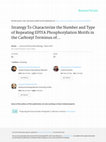
Journal of Clinical Microbiology, 2007
Cytotoxin-associated gene A (CagA) diversity with regard to EPIYA-A, -B, -C, or -D phosphorylatio... more Cytotoxin-associated gene A (CagA) diversity with regard to EPIYA-A, -B, -C, or -D phosphorylation motifs may play an important role in Helicobacter pylori pathogenesis, and therefore determination of these motifs in H. pylori clinical isolates can become a useful prognostic tool. We propose a strategy for the accurate determination of CagA EPIYA motifs in clinical strains, based upon one-step PCR amplification using primers that flank the EPIYA coding region. We thus analyzed 135 H. pylori isolates derived from 75 adults and 60 children Greek patients. A total of 34 cases were found to be EPIYA PCR negative and were consequently verified as cagA negative by cagA-specific PCR, empty-site cagA PCR, and Western blotting. Sequencing of the remaining 101 PCR-positive amplicons confirmed that an accurate prediction of the number of EPIYA motifs on the basis of size distribution of the PCR products was feasible in all cases. Furthermore, our assay could identify closely related H. pylori subclones within the same patient, harboring different numbers of EPIYA repeats. The prevalence of CagA proteins with three EPIYA motifs (ABC) or four EPIYA motifs (ABCC) was the same within the adult and children groups. However, CagA species with more than four EPIYA motifs were observed exclusively within adults (8.6%), suggesting that CagA-positive strains may acquire additional EPIYA-C motifs throughout adulthood. Our strategy requires no initial cagA screening of the clinical isolates and can accurately predict the number of EPIYA repeats in single or multiple closely related subclones bearing different numbers of EPIYA motifs in their CagA, which may coexist within the same patient.
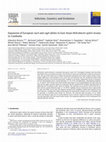
Infection, Genetics and Evolution, 2011
Helicobacter pylori infection is associated with gastric cancer (GC). The highest incidence rates... more Helicobacter pylori infection is associated with gastric cancer (GC). The highest incidence rates have been described in Asia, but regional variations exist that do not match the distribution of infection prevalence rates. The aim of the study was to examine the possible contribution of H. pylori virulence factors to geographic differences in the incidence of GC across East and Southeast Asia. We studied 66 isolates from Cambodian patients that had previously been assigned to two genetic populations based on sequences of seven housekeeping genes, namely hpEurope (n = 34, 51.5%) and hpEastAsia, subpopulation hspEAsia (n = 32, 48.5%). These strains were characterized with respect to vacA polymorphism and cagA status by PCR, and the CagA C-terminal region was sequenced. We also sequenced the complete cagA gene from 10 hpEurope and 10 hspEAsia strains chosen at random. The cagA gene was present in 92.4% of the 66 isolates and was mainly of Western type (n = 36, 59.0%). hspEAsia strains carrying East-Asian CagA and the m1-type vacA allele (15.2%) were less frequent among the 66 Cambodian isolates than reported in East Asian countries, a finding that might partly explain the intermediate incidence of GC in Cambodia, and by extension, in Southeast Asia (except for Vietnam). The observed high prevalence of s1a alleles (34.4%) and Western CagA (28.1%) among hspEAsia strains indicates frequent introgression of European vacA and cagA alleles into East Asian H. pylori strains. This expansion might have severe consequences for individual disease outcome.

FEBS Journal, 2015
As a result of Helicobacter pylori adhesion to gastric epithelial cells, the bacterial effector c... more As a result of Helicobacter pylori adhesion to gastric epithelial cells, the bacterial effector cytotoxin-associated gene A (CagA) is translocated intracellularly, and after hierarchical tyrosine phosphorylation on multiple EPIYA motifs, de-regulates cellular polarity and contributes to induction of an elongation and scattering phenotype that resembles the epithelial to mesenchymal transition (EMT). Stromelysin-1/matrix metalloproteinase-3 (MMP-3) has been reported to induce a sequence of molecular alterations leading to stable EMT transition and carcinogenesis in epithelial cells. To identify the putative role of CagA protein in MMP-3 induction, we exploited an experimental H. pylori infection system in gastric epithelial cell lines. We utilized isogenic mutants expressing CagA protein with variable numbers of EPIYA and phosphorylation-deficient EPIFA motifs, as well as cagA knockout and translocation-deficient cagE knockout strains. Increased levels of MMP-3 transcriptional activation were demonstrated by quantitative real time-PCR for strains with more than two terminal EPIYA phosphorylation motifs in CagA. MMP-3 expression in total cell lysates and the corresponding culture supernatants was associated with CagA expression and translocation and was dependent on CagA phosphorylation. A CagA EPIYA phosphorylation-dependent increase in gelatinase and caseinolytic activity was also detected in culture supernatants by zymography. A significant increase in the transcriptional activity of the mesenchymal markers Vimentin, Snail and ZEB1 and the stem cell marker CD44 was observed in the case of CagA containing phosphorylation-functional EPIYA motifs. Our data suggest that CagA protein induces EMT through EPIYA phosphorylation-dependent up-regulation of MMP-3. Moreover, no significant increase in EMT and stem cell markers was observed following infection with H. pylori strains that cannot effectively translocate CagA protein.
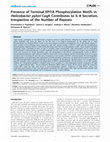
PLoS ONE, 2013
CagA protein contributes to pro-inflammatory responses during H. pylori infection, following its ... more CagA protein contributes to pro-inflammatory responses during H. pylori infection, following its intracellular delivery to gastric epithelial cells. Here, we report for the first time in an isogenic background, on the subtle role of CagA phosphorylation on terminal EPIYA-C motifs in the transcriptional activation and expression of IL-8. We utilized isogenic H. pylori mutants of P12 reference strain, expressing CagA with varying number of EPIYA-C motifs and the corresponding phosphorylation defective EPIFA-C motifs while preserving intact the CM multimerization motifs. These mutants had been previously closely scrutinized in terms of type IV secretion system functionality, CagA translocation and its subsequent phosphorylation. Following infection of gastric epithelial cell lines, transcriptional activation of IL-8 gene and secreted IL-8 levels were found to be strictly dependent upon the functionality of the EPIYA-C phosphorylation motifs, as EPIFA-C phosphorylation-deficient CagA expression failed to induce full IL-8 transcriptional activity. Interestingly, levels of IL-8 gene activation and of secreted IL-8 were the same, irrespective of the number of EPIYA-C terminal repeats. We monitored IkBα phosphorylation and confirmed CagA involvement in NF-kB activation. Furthermore, we observed that presence of EPIYA-C functional phosphorylation motifs contributed to NF-kB activation. NF-kB upstream signaling events, such as early ERK1/2 and AKT activation were confirmed to be independent of EPIYA-C phosphorylation. On the contrary, use of TAK1 specific inhibitor 5Z-7-Oxozeaenol resulted in complete arrest of IL-8 secretion, in a dose-dependent manner, irrespective of CagA status. H. pylori-infected TAK1(-/-) mouse embryonic fibroblasts (MEFs) failed to induce NF-kB activity, unlike the respective control MEFs. CagA and TAK1 were found to immunoprecipitate together, irrespective of CagA EPIYA-C status, thus confirming earlier reports of TAK1 and CagA protein interaction. Our data suggest that CagA may potentially interfere with TAK1 activity during NF-kB activation for IL-8 induction in early H. pylori infection.
Journal of Clinical Microbiology, 2009
The presence of various numbers of EPIYA tyrosine phosphorylation motifs in the CagA protein of H... more The presence of various numbers of EPIYA tyrosine phosphorylation motifs in the CagA protein of Helicobacter pylori has been suggested to contribute to pathogenesis in adults. In this prospective study, we characterized H. pylori isolates from symptomatic children, with reference to the diversity of functional EPIYA motifs in the CagA protein and vacA isotypes, and assessed the potential correlation with the histopathological manifestations of the infection. We analyzed 105 H. pylori isolates from 98 children and determined the diversity of EPIYA motifs in CagA by amplification and sequencing of the 3 variable region of the cagA gene as well as vacA isotypes for the signal, middle, and intermediate regions.
Journal of Clinical Microbiology, 2010
Helicobacter pylori factors CagA and VacA contributes to bacterial virulence. The presence of one... more Helicobacter pylori factors CagA and VacA contributes to bacterial virulence. The presence of one CagA EPIYA-C site is an independent risk factor for gastroduodenal ulceration (odds ratio [OR], 4.647; 95% confidence interval [CI], 2.037 to 10.602), while the presence of the vacA i1 allele is a risk factor for increased activity (OR, 5.310; 95% CI, 2.295 to 12.287) and severity of gastritis (OR, 3.862; 95% CI, 1.728 to 8.632).
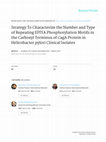
Journal of Clinical Microbiology, 2007
Cytotoxin-associated gene A (CagA) diversity with regard to EPIYA-A, -B, -C, or -D phosphorylatio... more Cytotoxin-associated gene A (CagA) diversity with regard to EPIYA-A, -B, -C, or -D phosphorylation motifs may play an important role in Helicobacter pylori pathogenesis, and therefore determination of these motifs in H. pylori clinical isolates can become a useful prognostic tool. We propose a strategy for the accurate determination of CagA EPIYA motifs in clinical strains, based upon one-step PCR amplification using primers that flank the EPIYA coding region. We thus analyzed 135 H. pylori isolates derived from 75 adults and 60 children Greek patients. A total of 34 cases were found to be EPIYA PCR negative and were consequently verified as cagA negative by cagA-specific PCR, empty-site cagA PCR, and Western blotting. Sequencing of the remaining 101 PCR-positive amplicons confirmed that an accurate prediction of the number of EPIYA motifs on the basis of size distribution of the PCR products was feasible in all cases. Furthermore, our assay could identify closely related H. pylori subclones within the same patient, harboring different numbers of EPIYA repeats. The prevalence of CagA proteins with three EPIYA motifs (ABC) or four EPIYA motifs (ABCC) was the same within the adult and children groups. However, CagA species with more than four EPIYA motifs were observed exclusively within adults (8.6%), suggesting that CagA-positive strains may acquire additional EPIYA-C motifs throughout adulthood. Our strategy requires no initial cagA screening of the clinical isolates and can accurately predict the number of EPIYA repeats in single or multiple closely related subclones bearing different numbers of EPIYA motifs in their CagA, which may coexist within the same patient.
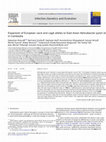
Infection, Genetics and Evolution, 2011
Helicobacter pylori infection is associated with gastric cancer (GC). The highest incidence rates... more Helicobacter pylori infection is associated with gastric cancer (GC). The highest incidence rates have been described in Asia, but regional variations exist that do not match the distribution of infection prevalence rates. The aim of the study was to examine the possible contribution of H. pylori virulence factors to geographic differences in the incidence of GC across East and Southeast Asia. We studied 66 isolates from Cambodian patients that had previously been assigned to two genetic populations based on sequences of seven housekeeping genes, namely hpEurope (n = 34, 51.5%) and hpEastAsia, subpopulation hspEAsia (n = 32, 48.5%). These strains were characterized with respect to vacA polymorphism and cagA status by PCR, and the CagA C-terminal region was sequenced. We also sequenced the complete cagA gene from 10 hpEurope and 10 hspEAsia strains chosen at random. The cagA gene was present in 92.4% of the 66 isolates and was mainly of Western type (n = 36, 59.0%). hspEAsia strains carrying East-Asian CagA and the m1-type vacA allele (15.2%) were less frequent among the 66 Cambodian isolates than reported in East Asian countries, a finding that might partly explain the intermediate incidence of GC in Cambodia, and by extension, in Southeast Asia (except for Vietnam). The observed high prevalence of s1a alleles (34.4%) and Western CagA (28.1%) among hspEAsia strains indicates frequent introgression of European vacA and cagA alleles into East Asian H. pylori strains. This expansion might have severe consequences for individual disease outcome.
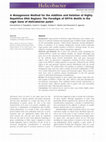
Helicobacter, 2013
Background: CagA protein of Western origin Helicobacter pylori isolates contains at its carboxyl-... more Background: CagA protein of Western origin Helicobacter pylori isolates contains at its carboxyl-terminal end repeating types of EPIYA motifs, depending on the surrounding sequence, which dictate hierarchic tyrosine phosphorylation. To produce, in an isogenic background, mutant strains expressing CagA protein with variable numbers of EPIYA-C terminal motifs, we have adopted a mutagenesis assay using a megaprimer approach. Materials and Methods: The H. pylori P12 reference strain containing two terminal EPIYA-C motifs was utilized. Initially, we cloned, full-length cagA gene, next to the Campylobacter jejuni kanamycin-resistance cassette, followed by the 1200-bp region located immediately after cagA gene (metacagA region). Then, we generated a megaprimer consisting of three consecutive copies of the EPIYA-C coding sequence of cagA gene, followed by the 140-bp region of the cagA genomic sequence present immediately after the second EPIYA-C repeat. We utilized these two products to perform a QuikChange mutagenesis assay and were able to obtain all desired combinations of EPI-YA-C motifs, followed by Kan r cassette and metacagA region. These constructions were used to perform natural transformation of the P12 parental strain, by directional homologous recombination. Results: We produced isogenic H. pylori strains that express CagA with variable number of EPIYA-C motifs (AB, ABC, ABCCC) and their phosphorylation-deficient counterparts. They exhibited similar growth characteristics to the parental strain, adhered equally well to gastric cells and successfully translocated CagA, following pilus induction. Conclusions: Our method can be used in other cases where highly repetitive sequences need to be reproduced. d XbaI restriction site underlined. e Abbreviations for the type of reactions in which they were used con: construction, seq: sequencing, mut: mutagenesis.
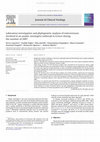
Journal of Clinical Virology, 2009
Background: Aseptic meningitis is the most commonly observed CNS infection and is mainly attribut... more Background: Aseptic meningitis is the most commonly observed CNS infection and is mainly attributed to Non-Polio Enteroviruses (EV). Objective: Identification and genetic analysis of the EV involved in the recent aseptic meningitis outbreak which occurred in Greece, during the summer of 2007. Study design: In total, 213 CSF and faecal samples were examined for EV presence by culture, while enteroviral RNA detection was performed by nucleic acid sequence-based amplification assay (NASBA). EV strains were typed by seroneutralization, as well as nested RT-PCR followed by VP1-2A gene partial sequencing. Phylogenetic analysis was carried out for the identification of the genetic relatedness among the isolated EV strains. Results: EV detection rate in CSF and faecal samples was 43.9% and 70.8%, respectively. EV serotyping and VP1 region analysis revealed the predominance of echovirus 4 (ECV4) serotype and the circulation of ECV6, 9, 14, 25, Coxsackie A6, A15, A24 and Coxsackie B1 serotypes. All ECV4 isolates presented a 98.7% similarity in nucleotide sequence, with a Spanish ECV4 strain, isolated during a meningitis outbreak in 2006. Conclusions: It is the first time that ECV4 is associated with an aseptic meningitis outbreak in Greece, during which 9 different EV serotypes were co-circulating. All Greek ECV4 isolates were closely related to the Spanish ECV4 strain. Genetic analysis of the VP1 gene can significantly contribute to the revelation of the endemic EV strains circulation pattern and their phylogenetic relationship with enteroviruses involved in epidemics of distant geographical areas at different time periods.








Uploads
Papers by Konstantinos Papadakos